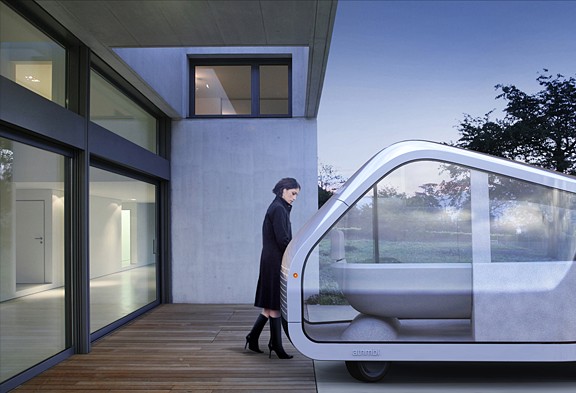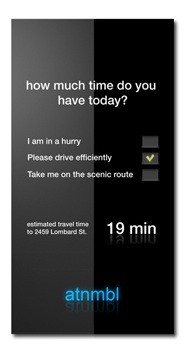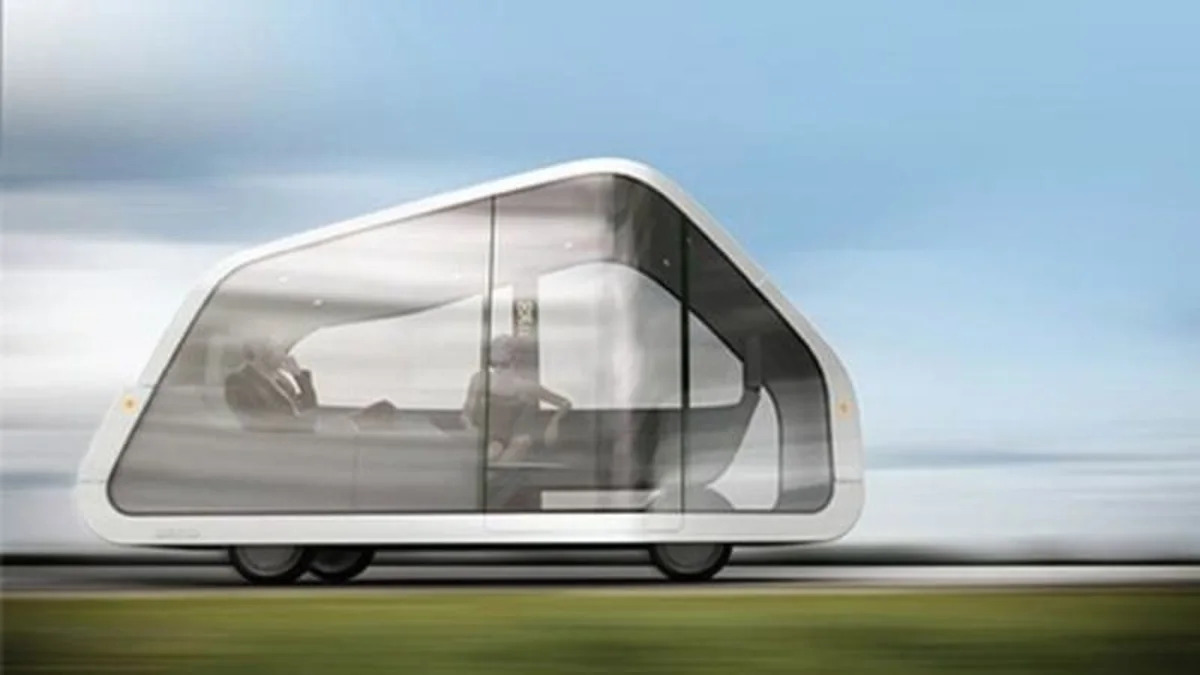Autonomobile - Click above for gallery
As a user of the terrible (IMHO) Google G1 phone, the news that the design team responsible for the look of the handset was releasing images for a new concept vehicle called the Autonomobile (alternately, the ATNMBL) didn't exactly inspire confidence. Reading over the ideas that Mike and Maaike used to create the ATNMBL, though, shows that one bad product - and the G1's main problem might be the Android software more than the design - shouldn't prohibit one from trying again.
Mike and Maaike tried to convey with the Autonomobile that we're approaching "the end of driving." The "auto" part of the name hints at the autonomous, self-driving nature of the all-electric vehicle. Instead of steering, braking and watching for traffic, you can sit in the living room-like interior and watch TV after telling car where you want to go. The car's initial question when someone gets in is "Where can I take you?" and the occupants can request that the car drive fast, efficiently or along a scenic route.
Since the electric drivetrain is compact, with motors hidden in each wheel and batteries in the floor and solar panels on the roof, the ATNMBL has wrap-around seating for seven but the overall size is smaller than most cars on the road today. There's more on the design of the ATNMBL over at Core77. Don't look for these on the streets just yet. Mike and Maaike dreamt up the concept to meet our transportation needs in 2040.
[Source: Mike and Maaike, Core77, Reuters]
PRESS RELEASE:
ATNMBL - The End of Driving
ATNMBL is a concept vehicle for 2040 that represents the end of driving and explores an alternative approach to car design. Upon entering ATNMBL, you are presented with a simple question: "Where can I take you?" There is no steering wheel, brake pedal or drivers seat. ATNMBL drives for you.
Electric powered, solar assist, with wrap-around seating for seven, ATNMBL offers living and/or working comfort, views, conversations, entertainment, and social connectedness. The vehicle is designed from the inside out with elements influenced by architecture and domestic interior spaces. The ATNMBL proposes a new standard of performance, one of timesaving and quality of life rather than speed, styling and acceleration.

The ATNMBL project is meant to provoke thought and encourage important conversations about the car industry's next destination. We believe a shift must take place from styling cars to redefining them. We are at an unprecedented crossroads: With industrial, financial, and environmental challenges also come unprecedented new opportunities and amazing new technologies.
 Design
Design
From the outside, ATNMBL looks like micro-architecture. Large windows, a pitched roof and asymmetrical from every view, it is designed without any reference to automobiles of the past. In contrast to today's automobiles, where much of the car's space is reserved for engine and drive train, ATNMBL's mechanical components are densely packed and simplified, providing dramatically more interior space in a vehicle that is shorter than most cars on the road today. Electric motors in each wheel provide all-wheel drive. Electric power is stored underneath the seating and floor with additional power provided by solar panels on the roof. Within a gridded pattern on the front and rear is an array of headlights, tail lights and sensors.
Passengers enter ATNMBL from the curb side through an electric glass sliding door into a standing-height entryway. Inside, the seating arrangement is a direct reference to the familiar living-room setting of a couch, side chair and low table. Riders are oriented towards each other and to the view outside through the large floor-to-ceiling windows on both sides. Centrally oriented is a large flat display that features live trip information, maps, and entertainment. The display can slide up to reveal a bar behind. A new and comprehensive sense of control is introduced through voice recognition and a touch screen remote control (or one's personal phone), offering riders a wide range of trip planning, ride sharing and performance settings that can be very detailed for those who want elaborate control or extremely simple for those who would rather just relax and enjoy the ride.
Summary of Features:
• fully electric powered plus solar assist
• driverless navigation via GPS, Lidar, radar, stereo camera, accelerometers
• wrap-around seating for 7
• voice recognition and remote for real-time control/ input
• large display for info, searches, browsing, communication
• open-source software with downloadable apps for carpool and carshare through social networking, pre-loaded trips, city tours, virtual drivers, etc.
• live trip info on mini display
• electric door, standing height entryway
• all wheel drive with motors in each wheel
• very few mechanical parts (drive by wire)
• bar
About Mike and Maaike
Mike and Maaike is an industrial design studio that takes an experimental approach to design, creating progressive solutions for high and low tech products, furniture, wearables, environments, and vehicles. Maaike Evers is Dutch; Mike Simonian, Californian. Their distinct backgrounds and unique approach create strong conceptual foundations and a clear point of view. Equally inspired by the tradition of craft and the potential of industry, Mike and Maaike have designed and developed complex high-tech products as well as artful and personal objects. The studio, which has received recognition and awards from design publications and museums around the world, is based in San Francisco. Mike and Maaike partner with people, organizations and companies who value an informed, experimental approach to design and the unexpected results it brings.



Sign in to post
Please sign in to leave a comment.
Continue